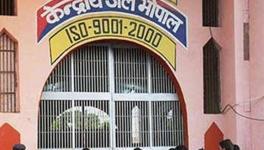Bhopal Jailbreak: Judicial Commission Gives Clean Chit to MP Police

The judicial commission of enquiry has given a clean chit to the Madhya Pradesh police and Anti-Terrorists Squad in the infamous Bhopal encounter wherein eight alleged SIMI activists were gunned down on a hilltop at Eitkhedi village – 12 kilometer from Bhopal city – on October 31, 2016, after they allegedly escaped from the high-security Bhopal Central Jail.
According to this report, the document prepared by the panel headed by Justice (retired) SK Pandey has “justified” the police action, given the situation that arose following the jailbreak. But it preferred to keep mum on the following unanswered questions raised that were raised after the shootout:
Did the suspects receive an insider’s help in scaling the 30-feet high wall of the most secure jail of Madhya Pradesh?
Why were only four out of 42 CCTV cameras installed in the jail premise not functioning on the Diwali night when the alleged jailbreak happened? (These cameras would have captured the alleged movements of the suspects)
Why were the cells, in which the undertrial SIMI prisoners were lodged, left unguarded?
A prahri (jail guard) was killed in cold blood. Why did the jail authorities not find it alarming?
How did the prisoners get access to weapons (.315 bore and 12 bore country-made pistols and sharp edge knives)?
If they had connections to get weapons, why couldn’t they get a vehicle to escape?
Why did all of them move together rather than dispersing and could not go beyond 10 kilometres in eight hours?
How did three cops receive knife wounds when bullets were used in the encounter? And why were the wounded policemen brought to public?
The report seems to have ignored the postmortem report, that mentioned that all the entry wounds on the suspects’ bodies measured between 0.4 to 0.5 cm in diameter, which is consistent with small calibre weapons. It means that the bullets were pumped in from a close range. The police claimed the encounter party used AK47, Insas rifles and pistols. Had they been fired at from AK47 or Insas rifles, the size of the entry wounds would have bigger in diameter.
The slain SIMI suspects, according to the post-mortem report, got bullet injuries either on the left and right sides of their chests, hips and backs or on their heads from a close range. This shows that the police team perhaps did not make attempt to catch the suspects alive. And they were fired at above their waists, which was in violation of the Supreme Court ruling that says that the police should fire below the waist.
The judicial commission report, which can be made public after placing it in the state assembly in Winter Session in December, has indicted jail officials for accommodating double the number of prisoners compared to the capacity of the prison. It has also held the authorities responsible for not raising alarm even after the jail guard had been murdered.
The report – submitted to the Additional Chief Secretary (general administration) Prabhanshu Kamal – approved the police theory, referring to the statements recorded by the villagers, that “fugitive” prisoners were armed and cops had asked them to surrender. But they opened fire on the police party that had surrounded them on the hilltop.
The commission’s report also said that the SIMI suspects had made a rope with bedsheets and used it to scale and jump the jail wall.
Get the latest reports & analysis with people's perspective on Protests, movements & deep analytical videos, discussions of the current affairs in your Telegram app. Subscribe to NewsClick's Telegram channel & get Real-Time updates on stories, as they get published on our website.




















